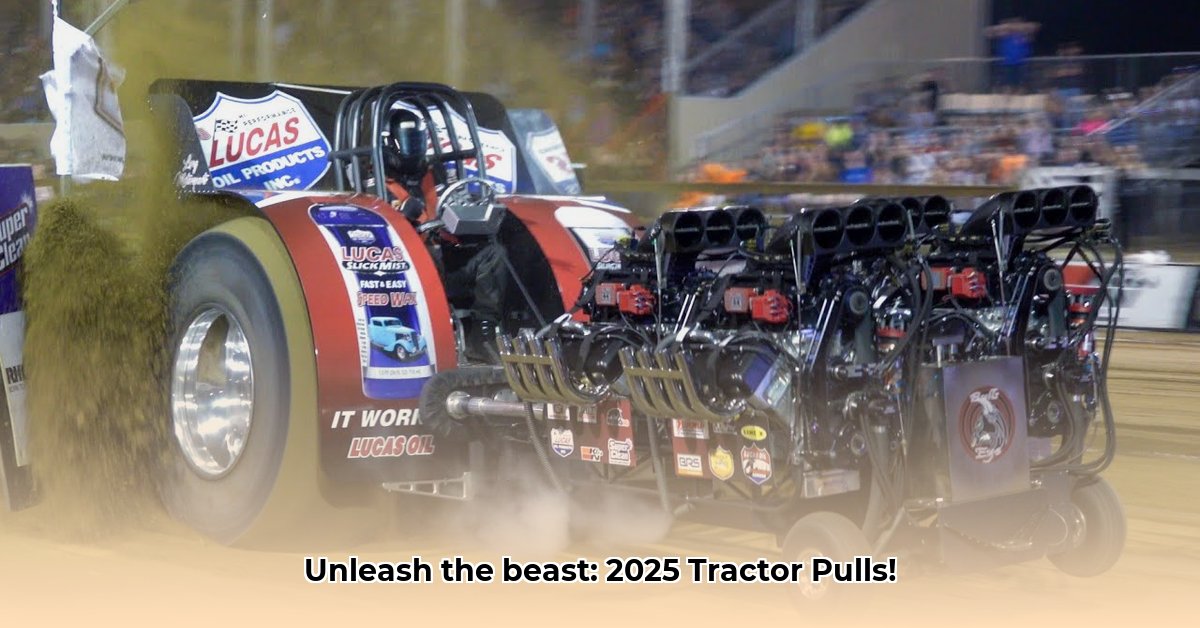
The Thunderous Symphony of Steel: A Deep Dive into Modified Tractor Pulling
Imagine the earth trembling beneath the relentless force of a supercharged tractor, its engine a roaring beast straining against a massive sled. This isn't your grandfather's farm equipment; this is modified tractor pulling, a thrilling motorsport blending raw power, precision engineering, and intense competition. This guide delves into the heart of this exhilarating sport, exploring its history, technology, and the challenges it faces in the 2025 season and beyond.
A Story of Power and Progress: The origins of tractor pulling trace back to early 20th-century America, where farmers' friendly competitions evolved into highly organized events. Early contests, featuring tractors already representing a huge leap in agricultural technology, laid the groundwork for the structured competitions we see today. Organizations such as the National Tractor Pulling Association (NTPA) and the International Tractor Pulling Association (ITPA) emerged to establish rules and class divisions. This structured environment has fueled the sport's growth and continues to attract competitors and fans alike. But how much do we really understand about the machines and the men and women who operate them? For more regional information, check out this Oregon tractor pull site: Oregon Tractor Pulls.
Under the Hood: Engineering Marvels
These aren't your average farm tractors. Modified tractor pulling machines are custom-built powerhouses, pushing the boundaries of engineering. Imagine engines, often adapted from race cars or airplanes, supercharged and tuned to deliver unimaginable torque. Think of it as creating a Formula 1 car, but instead of speed, the priority is sheer pulling power. Every component—from the transmission and axles to the tires—is meticulously designed and reinforced to withstand incredible stress. This level of engineering precision sets modified tractor pulling apart from other motorsports. But what are some of the key modifications that transform a farm tractor into a pulling champion? How do these critical design choices impact the tractor's performance and ability to handle the weight of the sled?
The Sled: The Ultimate Test
The sled, the weighted apparatus the tractors pull, isn't merely a piece of equipment; it's a sophisticated device crucial to fair competition. Its weight-adjustment system allows organizers to precisely control the challenge, ensuring that tractors of varying sizes and modifications face a relatively level playing field. It's engineered to provide consistent resistance, testing the limits of each tractor and its driver’s skills. What are the specific engineering principles behind the sled's design, and how does it ensure a fair and challenging competition?
Classes, Organizations, and the Rules of Engagement
The competitive landscape is shaped by different organizations, with the NTPA and ITPA being major players. These groups establish distinct rules and class divisions, categorizing tractors based on weight and horsepower to create balanced and exciting matchups. The rules vary slightly between organizations, ensuring fair competition within each group but also creating intriguing differences across competitions. What are some key differences between the NTPA and ITPA rules and class structures, and how do these differences influence the types of tractors that compete?
The Human Element: Drivers, Teams, and the Passion of Competition
Behind each modified tractor lies a dedicated team of mechanics, engineers, and drivers who pour countless hours into perfecting their machines. The driver plays a key role, not just controlling the tractor, but also anticipating the sled's resistance and expertly managing the machine's power. The combination of human skill and technological prowess creates a truly captivating display of power and precision. How critical is the driver's skill, and what are some of the key strategies and techniques employed during a pull? What role does teamwork play in achieving success in the intensely competitive world of modified tractor pulling?
The Future of the Sport: Sustainability and Challenges
Despite its popularity, modified tractor pulling faces significant challenges. Financial sustainability, securing sponsorships, and addressing environmental concerns are crucial. The considerable fuel consumption of these powerful machines raises serious environmental questions. However solutions are emerging, such as utilizing Hydrotreated Vegetable Oil (HVO) fuel which significantly reduces greenhouse gas emissions, representing a significant step towards a more sustainable future. The successful implementation of HVO and other environmentally conscious measures requires collaboration among competitors, organizers and sponsors. A collaborative approach can pave the way for a future where the thrill of the sport is balanced with environmentally sound practices.
Key Takeaways:
- The transition to alternative fuels like HVO significantly reduces the sport's carbon footprint.
- Standardizing emission measurement is crucial for transparency and accountability in environmental efforts.
- A collaborative approach involving competitors, organizers, sponsors, and spectators is vital for long-term environmental sustainability.
NTPA vs ITPA: A Comparison
| Feature | NTPA | ITPA |
|---|---|---|
| Geographic Reach | Nationwide | Primarily Midwest |
| Class Structures | Relatively consistent | May have regional differences |
| Rules & Regulations | Generally well-established | Varies slightly depending on location |
This is a simplified overview; further research is needed to fully understand the nuances of each organization.
The world of modified tractor pulling is a dynamic blend of engineering prowess, human skill, and intense competition. It's a sport steeped in history yet constantly evolving toward a more sustainable future. The roar of the engines and the thrill of the competition continue captivating audiences, promising a future where the power and passion of this unique motorsport stand the test of time.